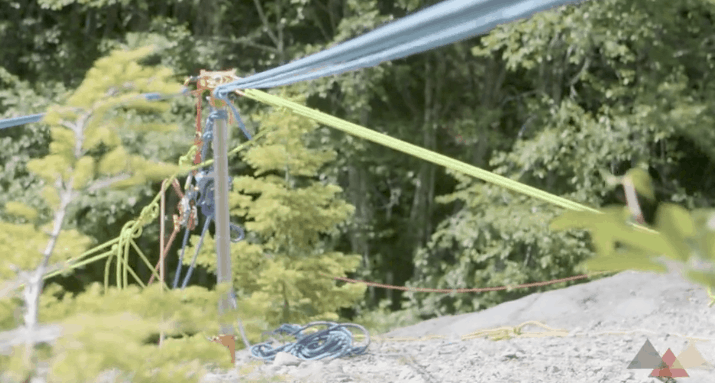The Ultimate Gear Guide for Artificial Highlines and Two-Tension Rope Systems
In the world of technical rescue and rigging, the idea of creating an “ultimate gear list” may seem like a pipe dream. However, by narrowing our focus to gear that excels in versatility, efficiency, and reliability, we can establish a foundation for building highly effective systems. This article explores the core concepts and tools behind artificial high directionals (AHDs) and two-tension rope systems (TTRS), with insights into why specific choices make all the difference.
The Thought Process Behind Gear Selection
When building this gear cache alongside experts like Jason Ilowite and Craig McClure, the goal was clear: develop a shared-tension system using only the most efficient gear while keeping complexity to a minimum. Here’s how we approached it:
- Start Simple: Begin with a clean slate to identify the most essential components.
- Efficiency First: Select gear that achieves maximum output with minimal overhead.
- Test and Adapt: Allow for experimentation and problem-solving in a controlled environment.
The goal was not perfection but creating systems that could be easily understood, replicated, and adapted as needed. By focusing on manageable, streamlined solutions, the team ensured readiness for real-world scenarios while minimizing the need for excessive equipment.
Key Tools in Artificial High Directionals and TTRS
- Artificial High Directionals (AHDs)
The Arizona Vortex takes center stage, offering unparalleled versatility with configurations like monopod, tripod, and easel A-frame. Its ability to adjust to various scenarios makes it indispensable for mountain rescue, confined spaces, and highlines. - Shared Tension Systems
Moving away from the traditional dedicated main and belay systems, shared tension systems distribute the load across two ropes. This approach minimizes edge friction, improves safety at transitions, and supports vertical lifting anchors for confined spaces. - Essential Gear
- Omni-block Pulleys: For efficient rope movement.
- AZTEK Kits: Perfect for quick setups and adaptable solutions.
- Kootenay and AZORP: Companion tools that enhance the Arizona Vortex’s capabilities.
By focusing on these tools, the course emphasizes learning more with less, teaching participants to prioritize implementation over excess gear.
Benefits of Shared Tension Systems and AHDs
- Edge Friction Mitigation
High directionals elevate the rope, minimizing friction at dangerous edges. - Improved Transitions
Smooth edge transitions reduce risk and increase operational efficiency. - Rigging for Highlines and Offsets
AHDs are invaluable for spanning gaps and establishing vertical lifting anchors. - Confined Space Versatility
The Arizona Vortex shines in tight, confined environments, offering adaptable configurations for unique challenges.
Learning the Craft
This workshop diverges from traditional training by using a variety of AHDs, including the Arizona Vortex, TerrAdaptor, and Vector, in multiple configurations. The focus is on teaching participants not just one application but a suite of approaches to enhance operations as a whole. Whether you’re a seasoned professional or exploring shared tension systems for the first time, this comprehensive course delivers invaluable insights and practical skills.
Explore the Arizona Vortex
As the ultimate AHD, the Arizona Vortex stands out for its flexibility and performance. Its modular design supports countless configurations, making it an essential tool for rigging professionals. To learn more and see the Arizona Vortex in action, check out Rigging Lab Academy for additional training and insights.
Final Thoughts
Rigging is an art as much as a science. By investing in the right tools, gaining proper education, and practicing relentlessly, you can elevate your rigging capabilities. This course provides the foundation for mastering AHDs and TTRS, setting the stage for confident, efficient operations in any scenario.
Peace on your Days
Lance










9 thoughts on “Artificial High Directionals”
Way cool, some valid points! I appreciate you making this article available, the rest of the site is also high quality. Have a fun.
This is a very good tips especially to those new to blogosphere, brief and accurate information… Thanks for sharing this one. A must read article.
Great post. I am facing a couple of these problems.
756374 457140You produced some very first rate factors there. I regarded on the internet for the issue and located many people will associate with together with your web site. 960719
Real Propecia Report stromectol queen 20mg acheter levitra generique
Someone necessarily lend a hand to make severely posts I might state. That is the very first time I frequented your website page and thus far? I surprised with the analysis you made to create this actual publish incredible. Fantastic job!
587559 256465hi!,I like your writing so much! share we maintain up a correspondence extra approximately your post on AOL? I call for a specialist on this space to solve my problem. May possibly be that is you! Seeking ahead to peer you. 596140
804835 485842Thankyou for all your efforts that you have put in this. very interesting information . 569681
526083 171226I located your weblog internet website on google and check some of your early posts. Continue to sustain up the superb operate. I just further up your RSS feed to my MSN News Reader. Looking for forward to studying extra from you in a while! 727330
Comments are closed.